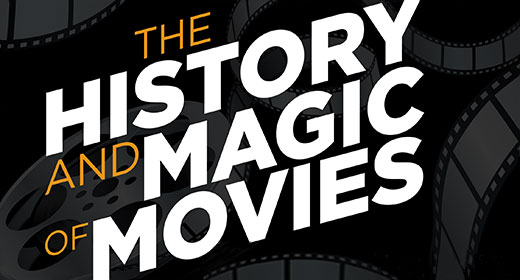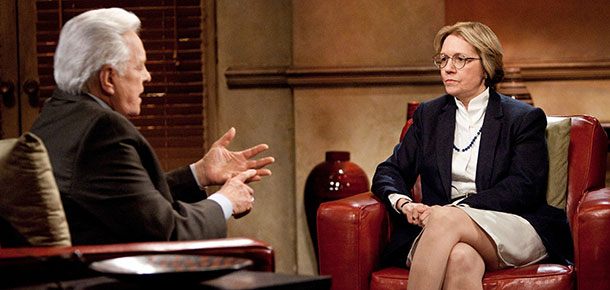
The History and Magic of Movies

Foreman with Turner Classic Movies host Robert Osborne during TCM’s Employee Co-host Festival in March 2011. She is introducing her movie pick, The Last of Sheila, a 1973 film written by Stephen Sondheim and Anthony Perkins, directed by Herbert Ross, and starring James Coburn, Richard Benjamin, Joan Hackett, and Dyan Cannon.
By Sarah Achenbach ’88
Consider the life-changing powers of Hayley Mills. In 1960, a five-year-old Alexa Foreman ’77 sat in the dark in Atlanta’s original Rialto Theater. On the screen was Mills, that pluckiest of Walt Disney darlings, smiling and beguiling her way through Pollyanna. It was Foreman’s first movie, and after the houselights came up, everything was different.
Like most of America, Alexa Foreman was smitten with child star Hayley Mills, but what she discovered that day at the theatre, popcorn in hand and eyes as wide as Mills’, was a passion for the magic of the movies. This love has inspired her career as a film historian, author, producer, and, since the early 1990s, senior researcher with Turner Classic Movies.
As a teenager, Foreman graduated to watching Bette Davis and other icons in classic Hollywood films shown on WTCG, Atlanta’s independent TV station. She even flirted with becoming an actress, but true to the Hollywood cliché, what she really wanted to do was direct: “I love the idea of putting together the whole production and being in charge, not just being in a scene.”
In 1973, Foreman’s first year at Hollins, there weren’t many female directors—or a clear path for women behind the camera, only in front of it. What Hollins had, though, was a film studies program and a liberal arts curriculum that welcomed—and expected—students to create new paths. “Hollins pushed me in the right direction,” says Foreman, who graduated with honors as a double major in English and film. “We were given full attention in class and full support as young women. We were able to cut to the chase and pursue the studies that we wanted.” And film was finally garnering the attention she always felt it deserved: “Film was getting to be established as an art form and looked at like literature. I also became fascinated with it as part of history.”
She knew a little about early women directors, editors, and screenwriters and learned more in film classes taught by English professor Richard H.W. Dillard and film professor Tom Atkins, such as Dillard’s Short Term class on films of the Great Depression. Foreman immersed herself in all things film at Hollins, creating a short film, penning a seventy-plus page senior thesis on Citizen Kane, and even serving a two-year tenure as president of the Hollins Cinema Society. (She laughingly admits that screening the Nancy Drew movies of her youth in Dana might not have been the most popular programming choice, but the experience helped secure subsequent jobs.)
Post-graduation, Washington, D.C., not Hollywood, beckoned. With Jimmy Carter in the White House, it was a good time to be a Georgian in the nation’s capital, even one interested in a seemingly incongruent career choice for a town steeped in politics. She landed a volunteer job with the American Film Institute, eventually working her way up to theater manager and a whopping $3,000-per-year paycheck. “My job was to get everyone in the theatre and handle complaints, but I saw movies I will never see again.” One such gem was a rare, nitrate (and highly flammable) print of The Scarlet Empress with Marlene Dietrich. “It was silver and glowed. That’s why they call it the ‘silver screen.’”
While in D.C., Foreman discovered an out-of-date encyclopedia of female directors and decided to write her own. Using her film knowledge gleaned at Hollins as the starting point, she researched Mary Pickford, Ida Lupino, Lillian Gish, Frances Marion, and other female film pioneers. “Women have been directing since 1895, but when movies started making money, the men pushed out the women,” she says. The result was Women in Motion (Bowling Green Popular Press, 1984), an in-depth history of women in film. Numerous articles and essays have followed, including co-authoring In the Picture: Stills from the TCM Archives (Chronicle Books, 2004), a book of captioned, behind-the-scenes stills from silent films to the 1960s.
Cut to a location change to Atlanta and a montage of film and unrelated jobs, including a six-month stint as program manager (and popcorn-popper, ticket-taker, plumber, and exterminator) for the Rhodes Theatre. For nearly five years, she worked for Films Incorporated renting sixteen-millimeter movies to colleges. “After videotape destroyed that market, I had several years of jobs that were taking me in a direction that I hated,” explains Foreman, who studied computer technology from Oglethorpe University during this time period. “There is not an easy or direct journey to one’s dream job.”
Cue the happy ending. In the early 1990s, Turner Broadcasting in Atlanta launched Turner Classic Movies, a TV channel devoted to the films Foreman loved. Her wealth of film knowledge and writing and researching talents were perfect for the role as researcher. Her early days with TCM played out a little like a scene from her favorite movie genre: the screwball comedy. While the host introduced the next film, Foreman sat just off-stage B.G. (Before Google), fingers at the ready and a mountain of film reference books at her feet. “I had books on the history of the Oscars and Leonard Maltin’s books, just in case Robert Osborne [TCM host] mentioned the number of films Jean Harlow did with Clark Gable.” Now senior researcher, Foreman researches every new title aired and works with the studio unit to make sure that all of the facts are correct.
A big perk of the job is the chance to work with the screen icons, past and present, including Meryl Streep, Sir John Gielgud, Sir Anthony Hopkins, Paul Newman, June Allyson, Jason Robards, Oprah Winfrey, Alec Baldwin, Drew Barrymore, and—yes—even Hayley Mills. Foreman has interviewed more than 100 actors, screenwriters, editors, etc., from Hollywood’s golden age for short pieces that run on TCM. She produced Memories of Oz, a TCM documentary about The Wizard of Oz, and on occasion directs Robert Osborne—the realization of her childhood dream of calling the action.
Another dream was naming an endowed scholarship at Hollins in memory of her biggest fan and fellow movie-lover, her mother Elizabeth Hitz Foreman. Her advice to anyone, not just burgeoning filmmakers: “Interview your family. It’s so important to capture their lives and memories.”
A screenwriter might not have plotted her path precisely as she’s taken it, but Foreman sees the value with every step—and nearly every one of the thousands of movies she’s watched and researched. “My life was leading to this job,” Foreman reflects. “Film is something that lasts. You can watch the same movie again and again, and it will never change. You can remember how you were when you first saw it. Seeing all the behind the scenes does not ruin it for me. It’s all part of the history and the magic.”
Sarah Achenbach ’88 is director of communications for Garrison Forest School in Baltimore. She writes for numerous regional publications and in 2008 co-authored Spirit of Place/Baltimore’s Favorite Spaces with photographer Bill McAllen, which City Paper named “Best Book About Baltimore.” She also wrote A Century of Spirit: Garrison Forest School, 1910-2010, a 180-page history of the school.
Credit:
Edward Pio-Roda, courtesy Turner Broadcasting
